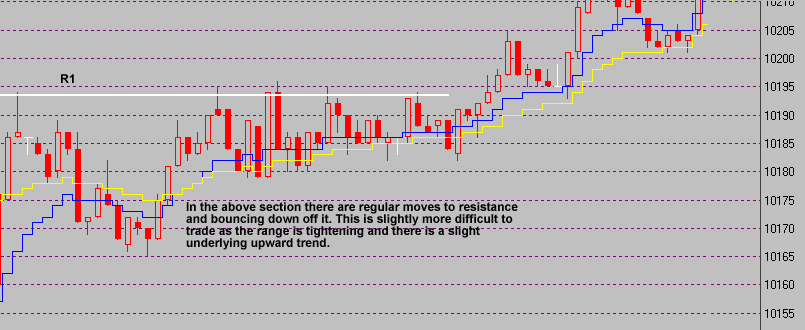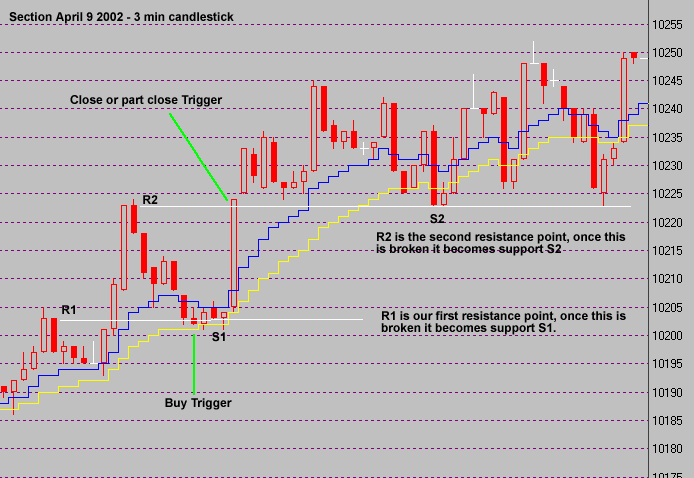Basics of trading the Dow using Support and Resistance
Method: Trading Support and Resistance in a sideways market
Trading at support and resistance levels using the following method is a good way of trading a market which is largely moving sideways and is range bound with regular peaks and troughs. These occur a number of times a week and are not unusual in the hour before lunch and into the lunch time ie. 11 am to 1 pm. There are some good references on the Internet on support levels and resistance levels. Please read and understand fully what support and resistance are before trying to trade using this method. It can also be a good way of getting into a major move before it happens.
Typically, if you use this method, the Dow will need to have been open for at least a hour. This gives it some time to mark some initial likely Support/Resistance points. Remember that these points will move during the trading day and you will need to constantly modify your view of where they are. You may also find yourself at times looking at multiple Support/Resistance levels, some of which will be more significant than others. Experience will allow you to sort the wheat from the chaff and identify the major ones.
I will typically use a 3 min 3 day candlestick chart to identify Support/Resistance levels. I have found this to be very reliable for intraday levels. I also use 12 and 24 period exponential moving averages overlaid on the chart to identify the current trend. To be honest these play little part in the trade trigger process but are useful for identifying a strong move (the curve is steeper) and can help to avoid opening a trade when there is obviously strong pressure in the current direction. To get a broader picture I will also use a 6 min 3 day candlestick and a 30 min 30 day chart which I will refer to occasionally.
When using Support/Resistance what you are trying to do is catch the Dow as it approaches one of these Support/Resistance levels and when the SB company quote is biased to the movement of the Dow continuing in the current direction. The following chart illustrates a typical move to a previously identified resistance level. The EMA’s identify that the trend is weak. The actual is rising on the chart. Look for a slowdown in rate of move and if it seems to be faltering at resistance then sell it even though it is still rising. Because you are selling during an upward move it is very likely that the SB quote bias will also still be upwards. This now works in your favour, you are selling when the the bias is still up rather than when it is neutral or down. Before entering the trade identify the next resistance level and if this is reasonably close use this as a stoploss or use a fixed number of points above the resistance level. Now, if the Dow bounces off the resistance level and starts to move downwards you are already in before the SB company has biased the price against you. Look to the next support level as the exit or if moving strongly as a part close point.
 |
The opposite technique is used to catch the upward moves. Look at the EMA’s and identify if the current trend is weak. Wait for the Dow to move down to the support point and buy it. Again, you should get the bias in your favour as you are buying when the SB company quote is biased downwards. Your target is the next resistance level.
If using the above method it is worthwhile identifying any further levels of expected support and resistance. Once you have a trade open and it is moving the way you wanted and if the move is strong then it is possible that it will move strongly through your identified exit point. If this is the case you need to have identified where the next exit point is likely to be.
The skill when using the above method is to exit when the SB company bias is still in your favour. Don’t wait for the Dow to turn before exiting as the SB company bias will also change at this point. Exit or part close as soon as the Dow has reached your target point.
Remember, this method is only useful when the Dow is trading sideways. Do not try to use it in a trending market.
Method: Trading Support and Resistance in a trending market
Trading using support and resistance levels is a good way of trading a market which is trending up or down. In a typical trending market there will be good pushes up or down followed by short spells of flat or opposing movement. To trade this it is important that you identify any major support or resistance levels from previous trading. Mark these on your chart. Now, as the market moves with the trend watch for the smaller pullbacks. Once a pullback has reversed and is moving with the trend again then buy or sell in the direction of the trend. Watch for the major Support/Resistance points, that you have marked, being broken. If the reversing movement breaks one of these then be cautious about re-entering as the trend could be broken. If the trend is approaching a major Support/Resistance point then be cautious here as well, it is possible that it will reverse or trade sideways for a while at this point. If it does bounce off a major Support/Resistance level then it is not unusual for it to retest this level at least once and possibly more before either penetrating or failing.
 |
Look at the reverses on the trend and see if they are roughly similar in duration and size. If they are then this is a good way of getting into the next trend move whilst the bias is still with you ie. whilst the SB company is still biased for the reverse . As the reverse approaches the point that you expect it turnaround and move back inline with the trend then buy or sell as appropiate for the trend. If the reverse continues past the expected turnaround point then stoploss the trade if necessary.
You can of course not trade the reverses at all but wait for Support/Resistance to be broken and trade in the direction the market is now moving. This is the more cautious approach but it is also the one which ensures you will always get a price which is biased aginst you. Any false triggers will be expensive as the bias will be against you on opening the trade and against you on closing it. My preference is to get in that little bit earlier when the bias is still with me (biased down if I’m buying or biased up if I’m selling) and then if I am wrong the cost will typically be the amount the Dow has moved against me without an extra bit for the spread betting company.


Join the discussion